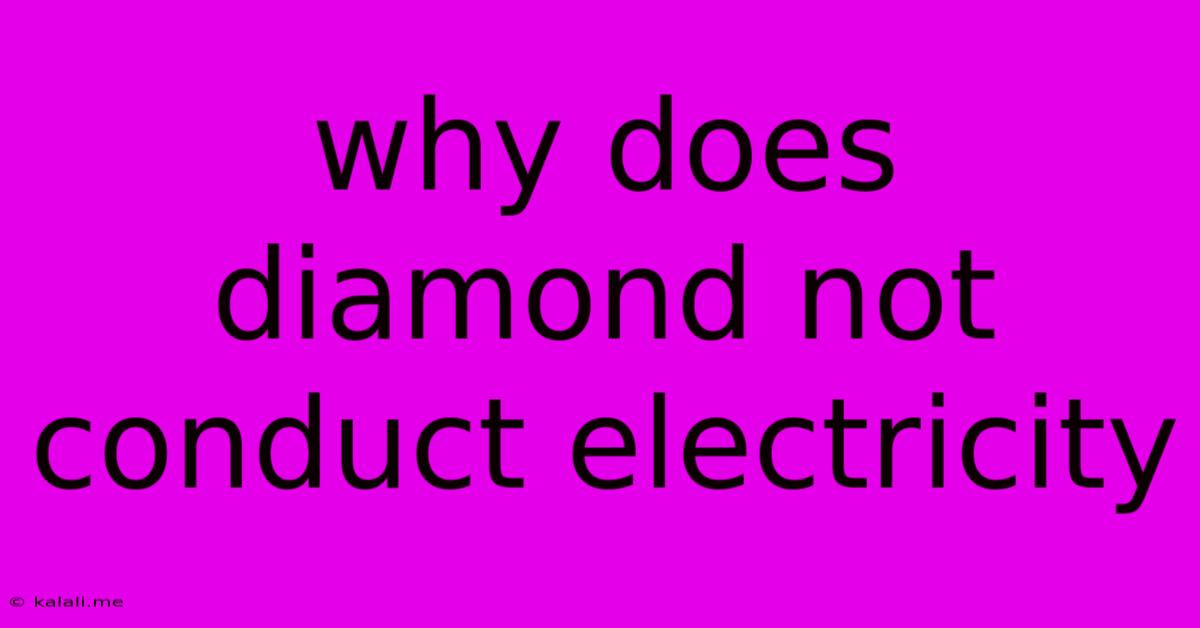Why Does Diamond Not Conduct Electricity
Kalali
May 21, 2025 · 3 min read

Table of Contents
Why Diamonds Don't Conduct Electricity: A Deep Dive into Carbon Bonding
Diamonds are renowned for their brilliance, hardness, and – perhaps surprisingly to some – their inability to conduct electricity. This unique property stems from the fundamental structure of the diamond crystal lattice and the way carbon atoms bond within it. This article will explore the reasons behind diamond's electrical insulation properties, contrasting them with other forms of carbon like graphite. Understanding this helps us appreciate the diverse properties of allotropes and their applications in various technologies.
Diamonds are essentially giant molecules of pure carbon. Each carbon atom forms strong covalent bonds with four neighboring carbon atoms, arranged in a rigid, three-dimensional tetrahedral structure. This creates a remarkably stable and tightly bound lattice. The key to understanding why diamonds don't conduct electricity lies in these covalent bonds and the absence of free electrons.
Covalent Bonding and Electron Localization
In a covalent bond, atoms share electrons to achieve a stable electron configuration. In diamond, these shared electrons are tightly bound within the strong covalent bonds between carbon atoms. Unlike in metals where electrons are free to move throughout the structure, diamond's electrons are localized, meaning they are restricted to their respective bonds and aren't free to roam and carry an electrical current.
This localization significantly increases the energy required to free an electron. The energy gap, or band gap, between the valence band (where electrons are bound) and the conduction band (where electrons can move freely) is extremely large in diamond. This large band gap effectively prevents electrons from jumping into the conduction band, even when an electric field is applied. Therefore, diamond exhibits a very high electrical resistivity, making it an excellent electrical insulator.
Comparing Diamond to Graphite: A Tale of Two Carbon Allotropes
Graphite, another allotrope of carbon, provides a stark contrast. Graphite's carbon atoms are arranged in layers, with strong covalent bonds within each layer but weak van der Waals forces holding the layers together. Within each layer, each carbon atom only forms three covalent bonds, leaving one electron delocalized and free to move. These delocalized electrons enable graphite to conduct electricity, making it a useful material in applications like electrodes and pencil lead.
This difference in electrical conductivity highlights the significant impact of bonding structure on material properties. The rigid, three-dimensional network of strong covalent bonds in diamond traps electrons, whereas the layered structure of graphite allows for electron delocalization and conductivity.
Applications Leveraging Diamond's Insulating Properties
Diamond's exceptional insulating properties, combined with its high thermal conductivity and hardness, make it invaluable in several high-tech applications. It's used in:
- High-power semiconductor devices: Its insulating properties prevent leakage currents and improve device performance.
- Heat sinks: Its high thermal conductivity efficiently dissipates heat.
- Cutting tools and abrasives: Its exceptional hardness makes it an ideal material for cutting and grinding applications.
- High-frequency electronic devices: Its electrical properties make it suitable for high-frequency applications where other insulators might fail.
In conclusion, diamond's inability to conduct electricity stems from its unique crystal structure and strong covalent bonding. The localized electrons within the covalent bonds cannot move freely to carry an electrical current, resulting in high electrical resistivity and making it a highly effective insulator. This property, combined with its other advantageous characteristics, makes diamond a highly sought-after material in various technological applications.
Latest Posts
Latest Posts
-
Laying A Floating Floor On Concrete
May 21, 2025
-
Work Cut Out For You Meaning
May 21, 2025
-
What Is A Country Of Residence
May 21, 2025
-
Why My Car Heater Blows Cold Air
May 21, 2025
-
When Life Gives You Lemons Meaning
May 21, 2025
Related Post
Thank you for visiting our website which covers about Why Does Diamond Not Conduct Electricity . We hope the information provided has been useful to you. Feel free to contact us if you have any questions or need further assistance. See you next time and don't miss to bookmark.